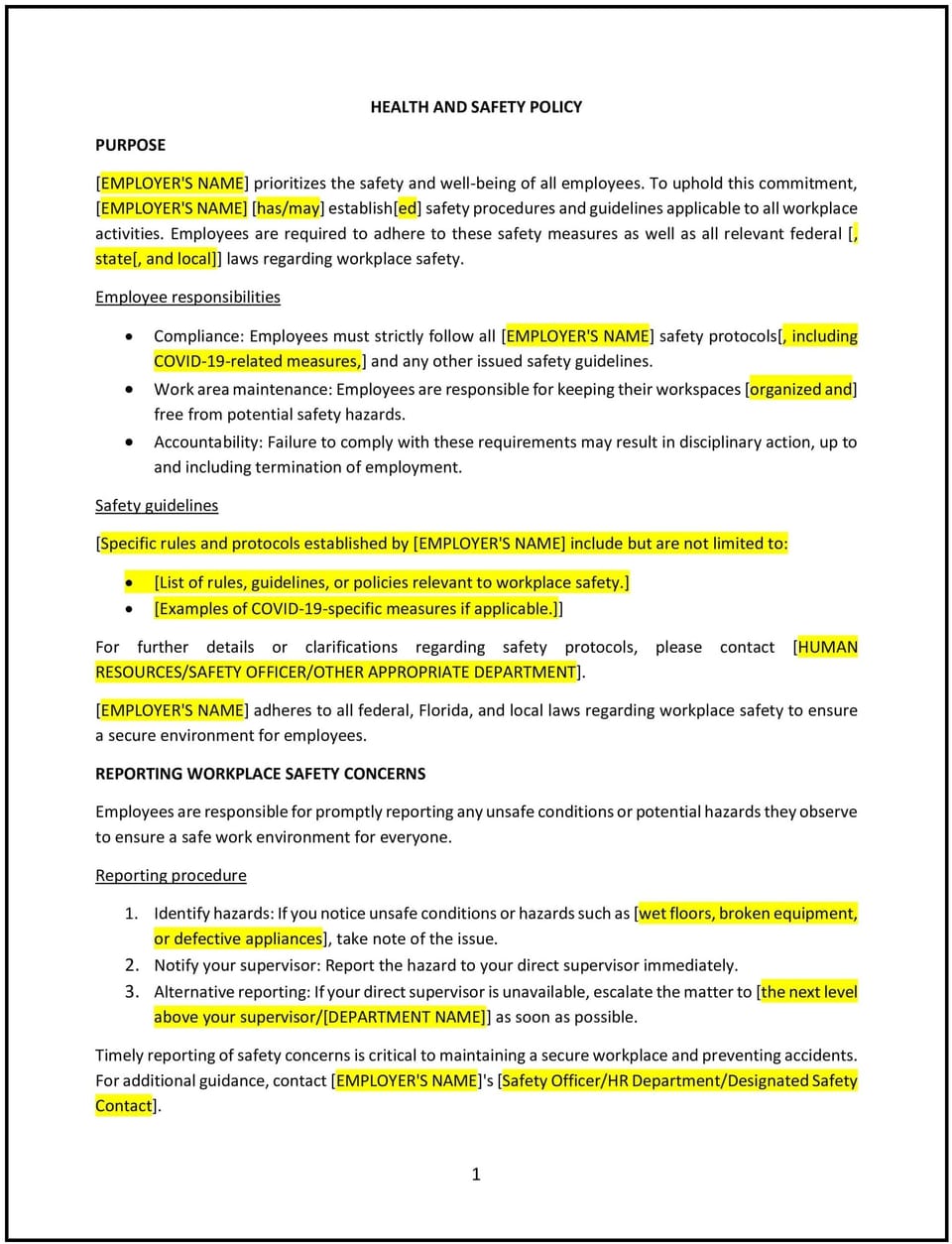Health and safety policy (Florida): Free template

Health and safety policy (Florida)
A health and safety policy helps Florida businesses create a safe and healthy workplace by identifying risks, implementing preventive measures, and promoting employee well-being. This policy outlines procedures for managing hazards, responding to emergencies, and fostering a culture of safety. It is designed to reduce accidents, protect employees, and provide clear guidelines for maintaining a secure work environment.
By implementing this policy, businesses in Florida can demonstrate their commitment to employee safety, enhance operational efficiency, and align with the state’s focus on protecting workers and communities.
How to use this health and safety policy (Florida)
- Identify workplace hazards: Clearly specify potential risks in the workplace, such as slips, trips, chemical exposure, or equipment-related dangers.
- Establish preventive measures: Outline steps to mitigate risks, including safety training, protective equipment, and regular inspections.
- Address emergency procedures: Explain how the business will respond to emergencies, such as fires, medical incidents, or natural disasters, including evacuation plans and communication protocols.
- Provide training: Educate employees on recognizing hazards, following safety protocols, and using protective equipment effectively.
- Communicate the policy: Share the policy with employees during onboarding and through regular communications to ensure awareness and understanding.
- Monitor adherence: Regularly review safety practices and address any concerns or discrepancies promptly.
- Update the policy: Periodically assess the policy to reflect changes in workplace dynamics, legal standards, or business needs.
Benefits of using this health and safety policy (Florida)
This policy offers several advantages for Florida businesses:
- Promotes safety: Clear guidelines help prevent accidents and create a secure work environment for employees and visitors.
- Reduces risks: Defined procedures minimize the likelihood of injuries, illnesses, or property damage.
- Builds trust: Demonstrates the business’s commitment to protecting employees and fostering a culture of care.
- Aligns with community values: Reflects Florida’s emphasis on safety, preparedness, and mutual support.
- Enhances reputation: A robust policy showcases the business’s dedication to ethical practices and employee well-being.
- Improves productivity: A safe workplace reduces absenteeism and ensures employees can focus on their tasks.
- Supports growth: A strong safety culture attracts talent and enhances operational efficiency.
Tips for using this health and safety policy (Florida)
- Communicate clearly: Ensure employees understand the policy by providing written materials and discussing it during meetings or training sessions.
- Train employees: Educate staff on recognizing hazards, following safety protocols, and responding to emergencies effectively.
- Use technology: Leverage tools like safety management software to track incidents, conduct inspections, and monitor compliance.
- Stay informed: Keep up with changes in safety regulations, industry standards, or best practices that may affect workplace safety.
- Encourage feedback: Solicit input from employees to identify areas for improvement and ensure the policy meets their needs.
- Review periodically: Assess the policy’s effectiveness and make updates as needed to reflect changes in workplace dynamics or business goals.
Q: Why should Florida businesses adopt a health and safety policy?
A: Businesses should adopt this policy to promote safety, reduce risks, and demonstrate their commitment to protecting employees and visitors.
Q: What types of hazards should businesses address in the policy?
A: Businesses should consider physical hazards (e.g., slips, trips), chemical hazards (e.g., toxic substances), biological hazards (e.g., infectious diseases), and ergonomic risks (e.g., repetitive strain).
Q: How should businesses handle workplace accidents?
A: Businesses should investigate accidents promptly, document findings, and take corrective actions to prevent recurrence while supporting affected employees.
Q: Should businesses provide personal protective equipment (PPE)?
A: Businesses should provide appropriate PPE, such as gloves, helmets, or goggles, and train employees on its proper use and maintenance.
Q: How can businesses prepare for emergencies?
A: Businesses should develop emergency response plans, conduct drills, and ensure employees know evacuation routes, communication protocols, and first aid procedures.
Q: What should businesses do if employees report safety concerns?
A: Businesses should address concerns promptly, investigate potential risks, and implement corrective measures while keeping employees informed.
Q: How often should businesses review the policy?
A: Businesses should review the policy annually or whenever there are significant changes in workplace dynamics, legal standards, or business operations.
This article contains general legal information and does not contain legal advice. Cobrief is not a law firm or a substitute for an attorney or law firm. The law is complex and changes often. For legal advice, please ask a lawyer.


